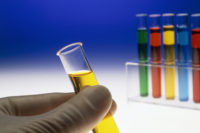Elf Atochem Opens New Polymer Technology Center
KING OF PRUSSIA, Pa. — Elf Atochem North America, Inc., Philadelphia, officially opened the doors to its new Polymer Technology Center (PTC) on March 30, 2000. The PTC centralizes R&D and technical support for the company’s three Performance Polymers business units, which were formerly located in three different areas. The company invested over 15 million dollars in the PTC to create a more efficient process, and to better serve customers and grow the company. Speaking of the center at its opening, Executive Vice President Jean Claude Rébeillé said, “We have tried to create a technical community.”
The PTC serves as a key resource in a network of polymer R&D and technical service centers of the recently merged Elf Aquitaine and Totalfina parent companies, reaching from the United States to Europe and Japan. This worldwide group of scientists and technical facilities, located in four countries, specializes in polymers such as polypropylene, polystyrene, polyethylene, polyvinylchloride, polymethylmethacrylate, polyamides and fluoropolymers. The merged companies coordinate their performance polymer R&D on a worldwide basis for synergy, speed and efficiency.
The three Performance Polymer business units represented at the center are:
- Technical Polymers
- Atoglas Division
- Functional Polymers.
Dr. L. Louis Hegedus, vice president Research and Development, Elf Atochem North America, notes that the new center covers the full spectrum of Performance Polymers’ research and development activities, ranging from exploratory lab work through projects in their conceptual, feasibility, developmental and commercialization phases.
According to Rich Rowe, president of Performance Polymers in North America, the company’s fundamental objective is sustaining profitable growth. “We recognize that our customers have choices,” he said at the facility opening. Elf Atochem hopes that the PTC will help achieve this by providing three things: It will bring the company closer to its customers; it will drive innovation; and it will put three technical teams together, creating an energized, motivated group of people.
Rowe says that the center represents an outstanding capability to work more closely with customers in the United States and beyond — developing new technologies and providing technical support. “Our focus is on core markets, where we can deliver measurable, differentiated value,” says Rowe. “In this sense we want to be a significant factor in our customers’ growth and success.”
The facility contains a wide variety of commercial-scale production equipment to support customer operations. In fact, the equipment, located in the high-bay process area of the building, occupies about a third of the facility. In addition, the facility contains several physical-testing and accelerated-weathering laboratories, which support the business units.
Research, development and technical service activities for the Technical Polymers business unit at the PTC seek to broaden the already impressive list of uses for polymers based on fluorochemistry and polyamide technology.
Recent notable developments in adhesive applications emerging from R&D include high-temperature, wash-resistant Platamid® copolyamide resin and Platherm® copolyester resin, which serve as hot melt adhesives for apparel. These resins are applied to interlining fabrics and nonwovens as powders, pellets and dispersions. The interlinings fuse to the fabric face in heated presses. Garments using these constructions have full fashion and form stability, and maintain their form after repeated dry cleaning and washing. Another adhesive development involves combining POLY B-D® resins with asphalt to improve joint sealants for bridges and other construction applications.
The product lines of the Functional Polymers Group include POLY B-D resins (hydroxyl terminated polybutadiene homopolymers), SMA® resins (styrene maleic anhydride copolymers), Orgasol® ultrafine polyamide powders, and functionalized polyolefin copolymers and terpolymers based on ethylene or propylene and modified with acrylate or maleic anhydride groups.
The family of POLY B-D resins includes hydroxyl- and vinyl-terminated polybutadiene homopolymers in addition to products that have epoxide functionality on the backbone. These resins are used to make elastomers that have outstanding low-temperature flexibility and hydrolytic stability, very low moisture-transmission rates, and excellent electrical insulation properties. Typically, the hydroxyl-terminated polybutadiene (HTPB) resins are reacted with isocyanates to yield polyurethanes that find utility in electrical potting and encapsulation, insulating glass window sealants, waterproof membranes and sealants for construction applications, adhesives, and binders for solid rocket motor propellants.
For more information on Elf Atochem, visit the company’s Web site at www.elf-atochem.com.
Links
Looking for a reprint of this article?
From high-res PDFs to custom plaques, order your copy today!




